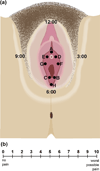Physical examination of the female cancer patient with sexual concerns: What oncologists and patients should expect from consultation with a specialist
- PMID: 26784536
- PMCID: PMC4860140
- DOI: 10.3322/caac.21337
Physical examination of the female cancer patient with sexual concerns: What oncologists and patients should expect from consultation with a specialist
Abstract
Answer questions and earn CME/CNE Sexual concerns are prevalent in women with cancer or cancer history and are a factor in patient decision making about cancer treatment and risk-reduction options. Physical examination of the female cancer patient with sexual concerns, regardless of the type or site of her cancer, is an essential and early component of a comprehensive evaluation and effective treatment plan. Specialized practices are emerging that focus specifically on evaluation and treatment of women with cancer and sexual function problems. As part of a specialized evaluation, oncologists and their patients should expect a thorough physical examination to identify or rule out physical causes of sexual problems or dysfunction. This review provides oncology professionals with a description of the physical examination of the female cancer patient with sexual function concerns. This description aims to inform anticipatory guidance for the patient and to assist in interpreting specialists' findings and recommendations. In centers or regions where specialized care is not yet available, this review can also be used by oncology practices to educate and support health care providers interested in expanding their practices to treat women with cancer and sexual function concerns. CA Cancer J Clin 2016;66:241-263. © 2016 American Cancer Society.
Keywords: cancer; female; physical examination; sexual dysfunction; survivorship.
© 2016 American Cancer Society, Inc.
Conflict of interest statement
Dr. Lindau and Ms. Abramsohn report no conflicts of interest.
Dr. Haefner reports no other conflicts of interest.
Dr. Streicher reports no conflicts of interest.
The following authors report no disclosures and no conflicts of interest: Baron, Florendo, Jhingran, Kennedy, Krane, Kushner, McComb, Merritt, Park, Siston, Straub.
All report no conflicts of interest.
Figures




References
-
- Baumgart J, Nilsson K, Evers AS, Kallak TK, Poromaa IS. Sexual dysfunction in women on adjuvant endocrine therapy after breast cancer. Menopause. 2013;20:162–168. - PubMed
-
- Fobair P, Stewart SL, Chang S, D'Onofrio C, Banks PJ, Bloom JR. Body image and sexual problems in young women with breast cancer. Psychooncology. 2006;15:579–594. - PubMed
Publication types
MeSH terms
Grants and funding
LinkOut - more resources
Full Text Sources
Other Literature Sources
Medical
Research Materials

